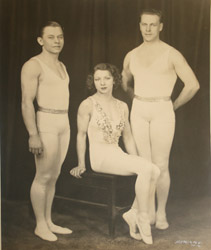While researching the history of the Gamma Phi Circus at Illinois State University, it became apparent that Bloomington’s circus ties don’t end—or start—there. According to Maureen Brunsdale, a librarian in ISU’s Special Collections and Rare Books department, circus performers used to spend the winters practicing their acts right here. With numerous railroad lines offering mobility and the low cost of living compared to Chicago and St. Louis, performers could spend most of their time in Bloomington and catch a train to any winter performances they were able to line up.
In the 1870s, Bloomington natives Fred and Howard Green left their hometown to join the circus. After falling in love with the trapeze, they returned home for the winter and set up some crude rigging in their father’s barn so they could practice. Their hope was to get hired as trapeze artists by a small circus, which they did. “They kept telling their friends, ‘You’ve got to come back to Bloomington because we’ve got these great barns. You can set up the rigging there and practice,’” said Brunsdale. By the 1880s, Bloomington was the winter quarters for a number of aerial acts, especially trapeze artists, a tradition which lasted through the 1950s. The Green brothers became famous trapeze artists under the name the LaVans, and later included their younger brother, Harold, in the act as well.
Other famous acts that wintered in Bloomington included The Flying Conciellos, the Flying Wards and Bob Fisher’s Five Fearless Flyers.
 While not born in Bloomington, Art Concello was raised there. He was taken off the streets by the director of the YMCA, who suggested he put himself to good use and learn the trapeze. Concello took the advice and later became one of the world’s finest trapeze artists. He even spent some time as the central attraction of the famous Ringling Bros. Barnum & Bailey Circus. Concello and his wife, Antoinette, also a trapeze artist, purchased a barn in Bloomington, where they wintered during their performance years. After he was done flying, Concello managed up to seven acts from Bloomington.
While not born in Bloomington, Art Concello was raised there. He was taken off the streets by the director of the YMCA, who suggested he put himself to good use and learn the trapeze. Concello took the advice and later became one of the world’s finest trapeze artists. He even spent some time as the central attraction of the famous Ringling Bros. Barnum & Bailey Circus. Concello and his wife, Antoinette, also a trapeze artist, purchased a barn in Bloomington, where they wintered during their performance years. After he was done flying, Concello managed up to seven acts from Bloomington.
While circus performers nationwide are familiar with Bloomington’s rich circus history and its development of world-famous aerial acts, its native residents are less aware. “When I started traveling around and talking to [circus people] from Florida to Michigan to Las Vegas, they all knew of our collection here,” said Brunsdale. “But I could go downtown and have a cup of coffee with some people, and they didn’t know about our collection or our past. I would love to turn the tides on that a little bit.”
And Bloomington wasn’t the only hot spot in central Illinois for circus wintering. “Galesburg was the earliest and most important winter quarters for circuses in Illinois,” noted Steve Gossard, curator of ISU’s circus collection. Due to the influence of a man named James T. Johnson, Galesburg housed circuses as early as the 1860s. Johnson had the idea to build barns in Galesburg, Macomb, Burlington and Quincy, and planned to travel the C.B.& Q. Railroad line, presenting winter circuses to make money in the off-season, Gossard explained.
Petersburg, Salem and Quincy were also popular winter destinations for circuses in the late 1800s and early 1900s, hosting performances by some of the nation’s greatest circus talent. Performers and ringleaders who wintered in these central Illinois towns often interacted with one another, taking advantage of having so much talent concentrated in the region.
Ed Shipp, who became the equestrian director of Ringling Bros. Circus and brought many of their finest performers to his Petersburg winter quarters, worked with the Flying Fishers and the Flying Wards of Bloomington. It was Shipp who gave these two groups the idea to build winter quarters in Bloomington, said Gossard. “Clyde Noble and Charles Waller of the Flying Fishers were instrumental in establishing the Bloomington YMCA as a winter training and performance facility.” It was there that ISU professor of physical education, Clifford “Pop” Horton, later took his students to perform, which led to his founding the Gamma Phi Circus in 1929. a&s


